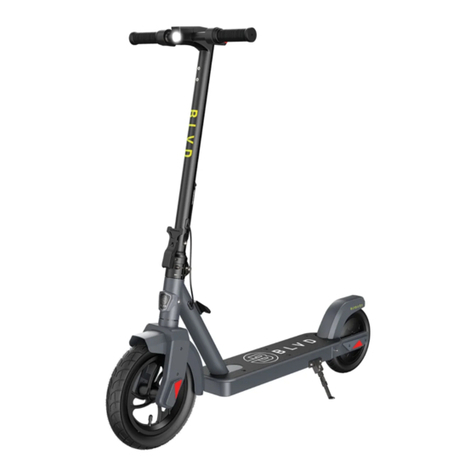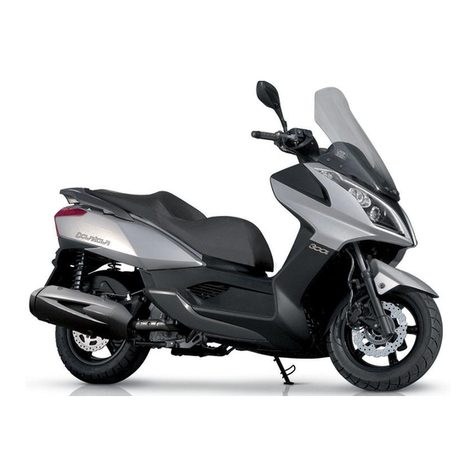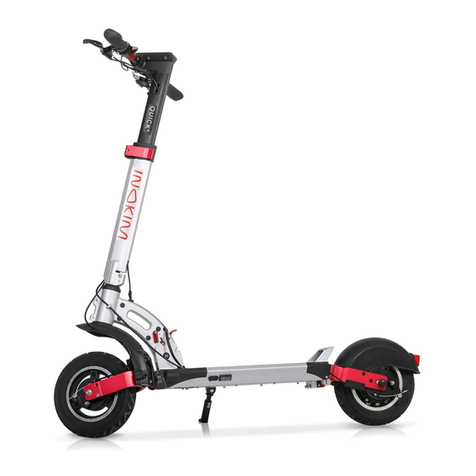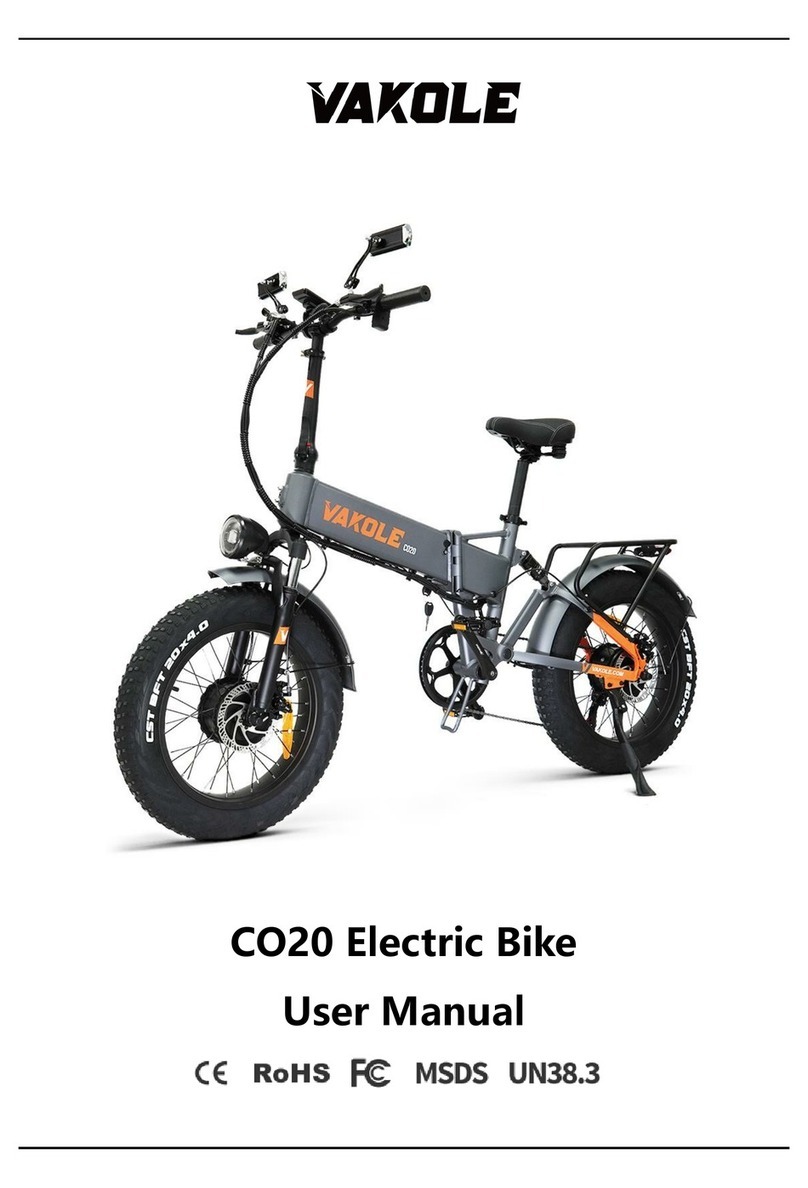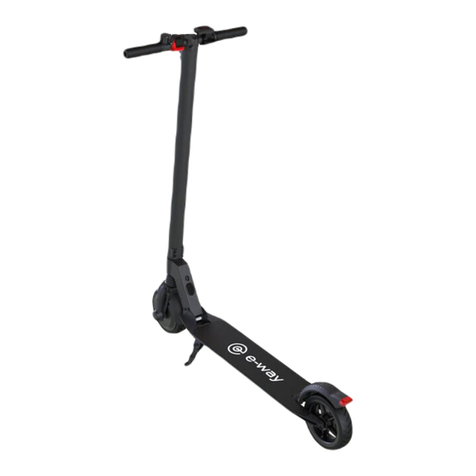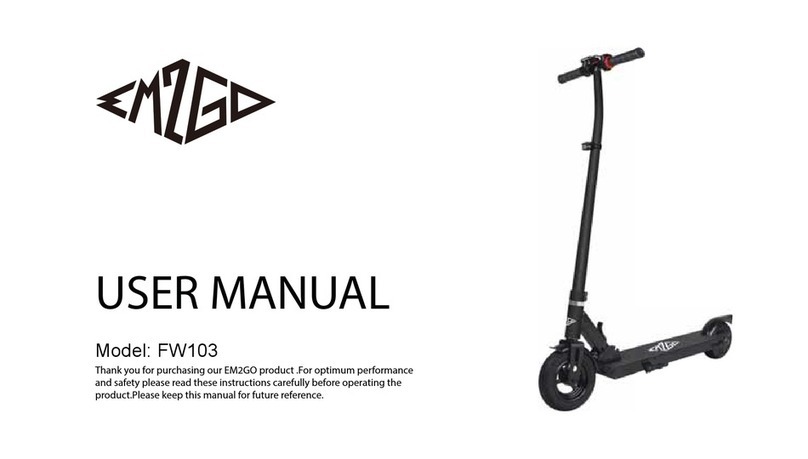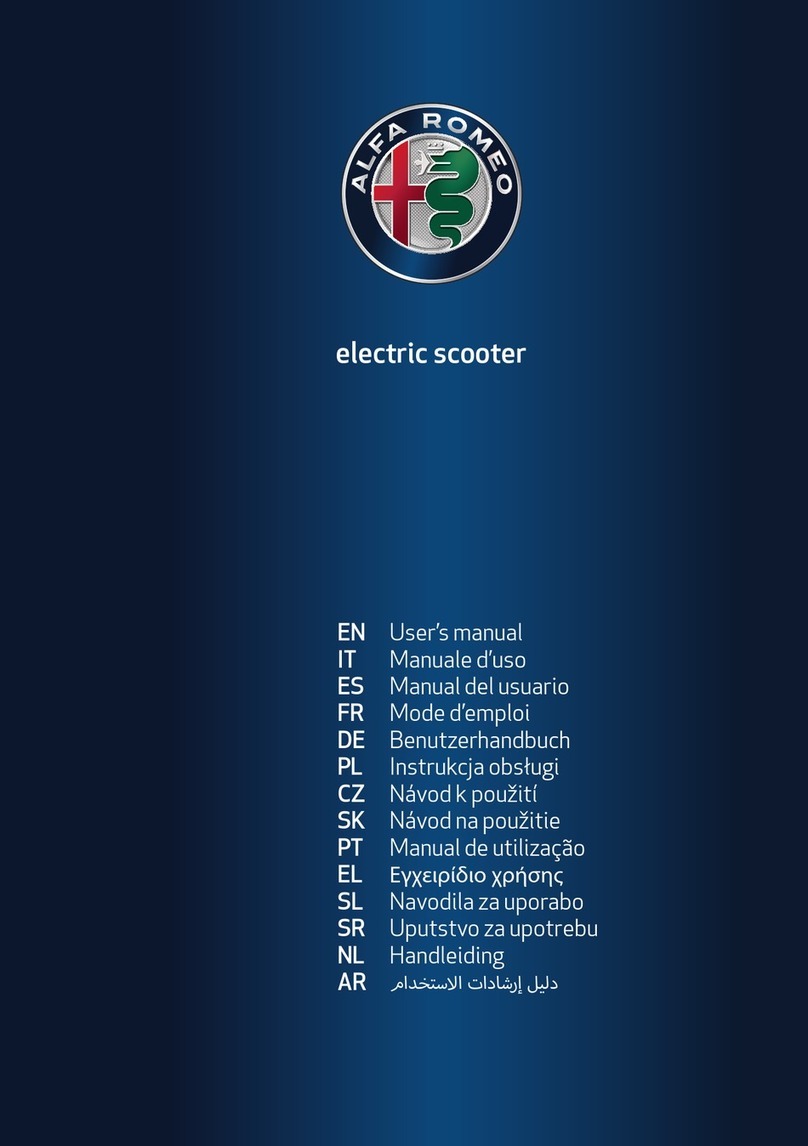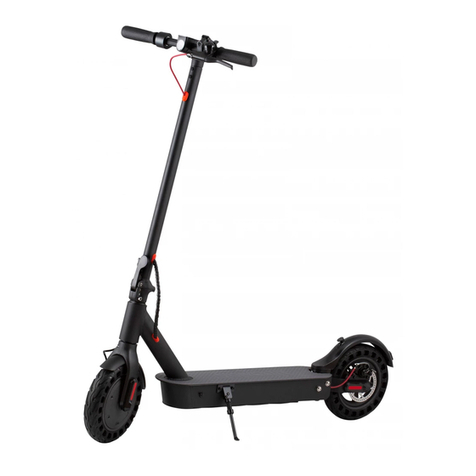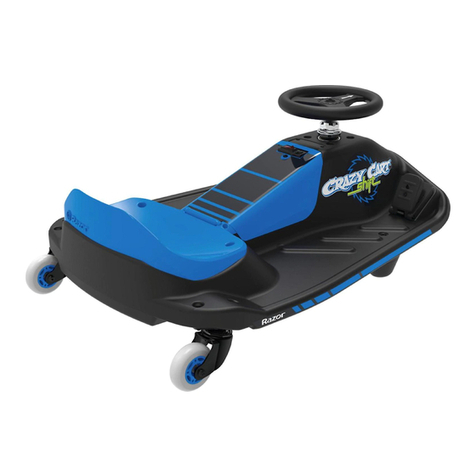Horizon Fitness Saxon User manual

Horizon Mobility Ltd
Mobility House (Block B)
Formal Industrial Park
Northway Lane
Tewkesbury
Gloucestershire GL20 8GY
Tel: 0870 458 1500
Fax: 0870 458 1501
Service Department: 0870 458 3000
Tel: 0870 458 1500 Fax: 0870 458 1501
Service Department: 0870 458 3000
Owners Manual
Saxon

If you have any questions about your new scooter,
please contact one of the help line numbers below
and our staff will be happy to assist you.
For Technical Assistance / Service Engineer Callouts
Horizon Service Centre 0870 458 3000
Service@horizon-mobility.com
For Any Other Queries
Horizon Head Office 0870 458 1500 - Tel
0870 458 1501 - Fax
Or contact us on the Internet at
Website
www.horizonmobility.com
e-mail
enquiries@horizonmobility.com
Support@horizonmobility.com
HORIZON MOBILITY
WARRANTY
L L W
, ,
, , -
, , ,
,
/
T Y W
F (3) , H
, , , ,
-
H / :
E, M/G
WARRANTY EXCEPTIONS
M: I
, -
. M
B: O .
B
BATTERY WARRANTY
B
H
W S H. D
H ,
.
WARRANTY EXCLUSIONS
ABS,
B ( - -
)
T T
BULBS, FUSES AND OTHER ELECTRICAL CONSUMABLES
U
Repairs and/or modifications made to any part of the vehicle without specific
prior written consent from Horizon
A H
Labour, service calls, shipping, and other charges incurred for repair of the
product unless specifically authorized by HORIZON
1

Introduction
The New Saxon
Fig. 1
Thank you for choosing the Saxon from Horizon Mobility Limited. Your vehicle
has been designed, developed and manufactured at our new factory in
Cheltenham United Kingdom. We at Horizon want you to obtain the very best from
your new Saxon mobility vehicle. This Owners Manual contains operating
instructions, tips on everyday use, battery charging and care instructions, as well
as general care and service information to keep your Saxon in the same
excellent condition that it left our factory.
Provided you follow the simple guides contained in this manual your
Saxon vehicle should provide many miles of motoring pleasure. Therefore it is
very important you the operator read this entire manual carefully
before first using your vehicle, and keep it with you when you are out as an easy
reference guide.
2

3
Fault codes
The Horizon Saxon has a fault diagnostic system built into the electronics. The
reverse warning buzzer is used to sound a two-digit code to indicate the nature
of the fault. The table below lists general faults and their codes. If in doubt tele-
phone your Main Dealer of Horizon Customer Care and by holding the telephone
next to the vehicle he may be able to tell you the problem and whether you can do
anything about it.
Service record
Code Probable Fault Solution
1 - 1 Motor short, controller failure Contact Main Dealer or Horizon
1 - 2 Controller software fault Contact Main Dealer or Horizon
1 - 3 Motor internal fault or short Motor brushes shorted or worn
2 - 1 Throttle pot faulty or wire broken Contact Main Dealer or Horizon
2 - 2 Improper key/throttle sequence Switch off wait 10secs and try again
2 - 3 Improper key/throttle sequence Switch off wait 10secs and try again
3 - 2 HPD fault (open throttle) Contact Main Dealer or Horizon
3 - 3 Throttle Fault Contact Main Dealer or Horizon
3 - 4 Electromagnetic brake fault Broken wire or replacement brake
4 - 1 Low battery voltage Charge batteries, loose terminal
4 - 2 Over-voltage Battery charger plugged in
Date Service Engineer
Pre - Delivery Inspection
Delivery Inspection
1st Annual Service
2nd Annual Service
3rd Annual Service
4th Annual Service
5th Annual Service
28
Features and Specification
Fig. 2
Index
A) Seat and adjustments (pages 8-11)
B) Control Levers (page 17)
C) Dashboard (pages 13-15)
D) Steering Column (pages 13-17)
E) Column Adjustment (pages 11-12)
F) Manual Freewheel (page 16)
G) Wheels & Tyres (page 5 & 28)
H) Batteries and their Charging (pages 5 & 22-26)
A
B
C
D
E
F
G
H

Safety Warnings and Operating Tips
General Safety
Safety is very important with any vehicle, especially a motor driven vehicle. The
following warnings are not conclusive and should be read in conjunction with this
complete manual, which explains operation, function, care and adjustments for your
vehicle.
If you are in any doubt about your ability to drive your vehicle due to a medical
condition or treatment, always consult your doctor before proceeding.
Always ensure your vehicle is switched off and the key removed before mounting,
dismounting or adjusting either the seat or steering column.
Always ensure you are seated comfortably and securely with the armrests down and
that both the seat and steering column are securely locked in their correct positions.
Ensure you have read this manual and familiarised yourself with all the controls
before using your vehicle for the first time.
Before switching your vehicle on, ensure you can reach all controls from a
comfortable seated position and ensure that your rear view mirrors are adjusted
properly.
Before driving your vehicle ensure that the lights are clean and work properly, ensure
your tyres are correctly inflated and undamaged, and that your batteries are charged.
Always reduce speed when turning corners especially when travelling downhill, over
uneven terrain or at high speed.
Never try to mount of dismount a kerb at an angle, always approach straight on and
at a steady speed. Never charge an obstacle at high speed. Wherever possible look
for and use drop kerbs, as these are safer and more comfortable.
Wherever possible always drive straight up or down slopes not across them.
Failure to observe these general safety tips could lead to your vehicle starting
unexpectedly, being uncontrollable or tipping over.
4
Routine Maintenance and service history
The following table gives an indication as to when routine maintenance checks
should be made.
Bulbs and Fuses
Wheels and tyres
If wheels are removed ensure that the axle shafts are well greased before
replacing wheels. Always use the “Binx” self-locking nuts provided with the scoot-
er. If lost contact your dealer for a new one as the thread is not a standard metric
one. If you remove the rear wheels always ensure you replace the drive keys in
the drive shafts to prevent damage to the drive and ensure the vehicle
operates correctly.
Electronics repair
Never try to open the control box, adjust the electronic controller or fix faults in
either the rear control systems or dashboard, the electronics have a number of
safety critical systems incorporated in them which must not be compromised in
any way. Contact your main dealer for help and assistance.
Day Week Month Quarter Annual
Charge batteries
Inspect battery terminals
Wipe vehicle over with damp cloth
Check tyre pressures (25—30P.S.I.)
Check seat swivel and slide system
Check rear for wire chaff and wear
Check tyres for damage and wear
Check front suspension for damage
Check manual brake function
Inspect motor brushes
Full service by main dealer
Voltage Rating
Headlight bulb 12v 21 watt
Front indicator bulbs 12v 5 watt
Rear indicator bulbs 12v 5 watt
Rear red tail light bulbs 12v 10 watt
Main ignition fuse (denoted by a red dot) 5 amp
Main 12volt fuse (denoted by a white dot) 8 amp
Main Battery circuit breaker (dealer only) 70 amp
Main charger circuit breaker (dealer only) 35 amp
27

Batteries
Before each journey always check that the batteries are sufficiently charged.
Always follow the procedures for battery care and charging set out on pages 21-26
of this manual.
Though your vehicles batteries are sealed, try to keep batteries upright on a flat
surface at all times, especially when being transported. When being transported
ensure your batteries are located securely in place to prevent damage or injury
Regularly check that your batteries are not damaged, are in good condition with
clean terminals and that no leakage has occurred.
Warning: battery fluids are very corrosive and every care should be taken at all
times to avoid contact with it. If it comes in contact with the skin, clothing or other
surfaces, wash immediately with generous amounts of soap and water. If it comes
in contact with the eyes, immediately flood the eyes with running fresh cold water
for at least 10 minutes and seek immediate medical advice. If it is swallowed seek
immediate medical advice.
Wheels and Tyres
Regularly check your wheels, tyres and steering for damage or foreign objects that
might cause improper performance or a puncture.
Check your tyres regularly for uneven wear. Seek advice from the Horizon Service
Department or your local Horizon dealer if found.
Do not inflate your vehicles tyres using a powered airline at a garage. Always use a
bicycle hand pump or a manual foot pump.
Tyres should be inflated to a pressure of 25-30 P.S.I. dependant on the desired
comfort of ride .
Freewheel Lever
The freewheel lever for your vehicle is located at the rear beside the inside edge of
the right-hand rear wheel.
Never attempt to use the freewheel lever on steep slopes.
Never sit on the vehicle while it is in freewheel as the vehicle will no longer
automatically stop.
5
Once fully charged the yellow light will go out and the green charger light will
come on. Charging is now complete but if the vehicle is not required it may be left
on, as the charger is fully automatic and will keep the batteries “topped up”
without fear of damage.
Never leave the charger connected to the vehicle batteries with the mains
switched off, as this could shorten battery life or cause permanent battery
damage.
Always plug the charger into the vehicle before plugging it into the mains and
turning it on.
Always switch off the mains before unplugging the charger from the vehicle.
Fig. 15
While the charger is plugged into your vehicle its drive system is disabled.
If you turn on your vehicle whilst it is charging your batteries the battery indicator
may still not have risen, this is because the gauge will only reset when the
batteries are full, the gauge will not elevate one bar at a time whilst charging.
26

Transporting your Saxon
The Saxon is not designed to be dismantled to fit in to a motor
vehicle. However it will fit into a hatchback or estate type vehicle.
If you require to transport your Saxon the seat and batteries can be
removed but remember that the batteries are very heavy (up to 24.3kg/ 53.6lbs
each).
Always ensure your Saxon and its parts are securely stowed and anchored when
being transported.
Never sit on your Saxon whilst it is being transported in another vehicle.
Never attempt to tow another vehicle with your Saxon or tow the Saxon with an-
other vehicle.
Do not carry passengers on your Saxon it is both dangerous and illegal.
Mobile telephones and two-way radios
Mobile telephones, two-way radios and “walkie-talkie” devices must never be
used while operating your vehicle.
The use of mobile telephones or two-way radios can cause excessively strong
electromagnetic fields that may interfere with the vehicle’s electronic systems.
If you need to use a mobile telephone or two-way radio, bring the vehicle to a
complete stop and turn off the ignition key before switching the device on.
Turning
Always reduce speed when turning corners especially when travelling downhill,
over uneven terrain or at high speed.
Emergency stop
Switching off the ignition key will cause your Saxon to come to a sudden and
complete halt using full braking. This method to stopping is not recommended
except in an emergency as regular use could damage the electromagnetic brake.
6
Charging instructions
Ensure your Saxon is switched off and the key removed.
Always charge your vehicle in a well-ventilated room with no exposed flame
present.
Place your battery charger on a hard flat surface; never place it on the carpet or a
surface likely to block the ventilation louvers in the base of the charger casing.
Never expose any part of your charger or batteries to direct heat or naked flame
(e.g. gas fire).
Never charge your vehicle outside or in an excessively damp room.
Never plug your charger in if any part of the charger or mains plug is wet.
Plug the charger into the charger socket on the steering column A (Fig. 13).
Fig. 13 Fig .14
Ensure that the mains plug is dry and free from damage before plugging it
into the mains socket and switching it on (Fig 14).
The yellow light should come on immediately and should remain on while the
vehicle is charging.
Once the batteries are charged the green charged light will illuminate.
25
A

Hill climbing (Maximum Safe Slope)
Wherever possible climb or descend slopes, hills or ramps directly facing the
slope of the hill rather than traversing across the slope.
The Saxon has been tested in accordance with EN 12184:1999 8.4.2 to climb a
continuous incline of more than 5 metres and less than 50 metres at 11o (1 in 5)
with a maximum user mass of 158kg (350lbs) (including luggage). Never attempt
to climb inclines in excess of this. For continuous inclines of more than 50 metres
in length you should never climb a slope of greater than 9.5o (1 in 6) with 158kg
(350lbs) maximum user mass (including luggage).
Kerb climbing
Never attempt to mount or dismount a kerb in excess of 100mm (4”), and where
possible choose the lowest height kerb available.
Do not attempt to mount or dismount kerbs in reverse as your vehicle has less
power and will be less stable.
Always mount or dismount kerbs at right angles slowly and steadily. Never race at
a kerb or try to negotiate one at an angle.
Fig. 3
7
Maintenance free VRLA batteries generally take longer to recharge than other
types of batteries so be patient, leave them on charge overnight, as the charger is
fully automatic.
Regularly check the connections on each battery terminal for signs of corrosion
and security. If any corrosion is present clean the lead terminal completely with a
wire brush or similar lightly abrasive product, ensuring you do not touch both
terminals at once. Re-grease the terminals using petroleum jelly (such as
Vaseline) never use ordinary grease products.
Once greased replace the battery connections, tightening the terminal bolts down
securely. Cover the terminal connections, bolts and wire tails with petroleum jelly.
Ensure the front and rear battery retaining clamps are fitted securely and are not
touching any battery terminals.
Vehicle range
It is a requirement that manufacturers state the range of their products in their
literature or Owners Manuals. There is a common European Standard for
measuring the range of a mobility vehicle, this is set out in ISO 7176 Part 4:
Energy consumption of electric wheelchairs and scooters for determination of the-
oretical range.
The tests are carried out in controlled environmental conditions with new, fully
charged batteries, on a level test surface.
The range figures stated should be considered as a theoretical maximum
distance obtainable and not what you will generally obtain from your Saxon in
everyday use.
Range will reduce due to battery age and state of charge, hilly terrain or slopes,
grass, mud or snow, regular kerb climbing, low air temperature, incorrect tyre
pressures, stop/start driving, worn motor brushes or vehicle due a service.
The technical considerations for range may seem daunting and complicated but
please remember that battery size and motor efficiency will be the two main
factors in determining range. Your Horizon Mobility Saxon has probably the high-
est battery capacity available on a mobility vehicle today, coupled with a highly
efficient 24volt transaxle drive system you should find the range of your
vehicle is sufficient for the majority of your everyday needs.
24

Assembly and adjustments of your Saxon
Seat removal and replacement
Depending on seat option fitted operate the seat back adjustment lever by pulling
upwards and while holding lever up fold the seat back down.
Operate the seat swivel lever on the side of the seat and turn the seat so that it
turns freely (not locked).
Fig. 4
Grasp the sides of the seat and pull upwards until clear of the vehicle seat post.
To put the seat back on the vehicle grasp the seat on either side then carefully
line up the socket in the top of the vehicle seat post with the seat spigot. Raise
the seat to the vertical position; it should now drop into place. If it is slightly stiff
and doesn’t drop into place turn the seat while pressing down on the seat of the
cushion until the seat locks into place.
Always ensure that the seat has locked into place by trying to turn the seat before
attempting to drive the vehicle.
Seat adjustment
Your Saxon has been designed so that the seat is adjustable for both height and
reach to ensure you are in the safest and most comfortable position when operat-
ing your vehicle.
Always adjust the seat to a suitable driving position as far forward on the vehicle
as is comfortable to do so rather than brining the steering column back to enable
you to reach as this will make steering slightly more difficult and reduce vehicle
stability.
8
Only ever use the Horizon approved charger supplied with your vehicle.
Do not interrupt the charging cycle of your charger.
Fig. 12
Charge your batteries every night regardless of the amount of use your vehicle
has had during the day. Keeping your batteries topped up will extend their life
and ensure the vehicle achieves desired range performance .
Do not top up your batteries during the day, wait until you have finished with the
vehicle for the day or the evening then leave them charging overnight for a full
charge.
If you are not using your Saxon today leave it connected to the charger until
required. Leave the charger switched on, this will not damage your batteries as
long as the mains connection is left switched on and will only use what power the
batteries require to remain topped us as the charger is fully automatic. Turning
the mains connection off will begin discharging the batteries and could eventually
shorten their life or cause them damage.
If you leave your vehicle for an extended period of time (more than a week)
disconnect at least one main battery terminal (the grey two pin connectors under
the rear battery cover). If leaving your vehicle for a long time, once a month plug
your batteries back in and leave on charge until fully charged, remember to
unplug the batteries once again once charged.
Failure to recharge your batteries will damage them and lead to shortened
lifespan and performance or permanent failure.
23

Where a rear basket or box has been fitted together with a flashing beacon we
recommend you do not try to swivel your seat as it may come into contact with the
beacon pole.
Fig. 5
Seat
height adjustment
To adjust the seat height, first follow the above steps for seat removal.
Remove the battery cover by releasing the locking toggles located at front corners
and rear centre edge of the cover. Lift the cover gently and turn through 90o. The
lighting loom plug should be released by pressing the rear end of the latch while
gently pulling the two halves apart.
Remove the nut and bolt A. (Fig. 5) located halfway down the seat post by means of
two 13mm metric spanners. Slide the seat post inner up or down as required before
reinserting the bolt through the post. Replace the nut and retighten securely to en-
sure the seat post is locked into place.
The Saxon seat post has been designed so that it may be adjusted 100mm (4”) in
increments of 25mm (1”).
Seat slide adjustment
The Saxon seat has been designed to slide 125mm in 6 positions. To adjust the seat
pull outwards gently on lever C. (Fig.5) at side of seat and slide seat back or forward
to the most comfortable position for you. Release lever and gently try moving seat to
ensure slide mechanism has automatically locked back into place.
9
Batteries and charging systems
General information
The batteries used as the power source of your Saxon mobility vehicle are signifi-
cantly different from other types of batteries such as the ones used to start your
car. Car batteries are designed to release large amounts of power quickly whilst
mobility vehicle batteries (common term for which is deep cycle) are designed
to release power slowly and evenly.
Mobility batteries are generally more expensive than other types of batteries, this
is because the technology used is more complicated and production runs are
much smaller.
Battery size for mobility vehicles is always described in amps per hour (e.g. 50A/
hr). The higher the number the larger the battery size, weight and capacity, so
potentially the greater the distance you can travel.
Battery type
Your Saxon mobility vehicle is supplied with “valve regulated lead acid batter-
ies” utilising a “Gel” electrolytic compound rather than the cheaper “glass mat”
technology that tends to have a shorter life expectancy. Battery capacity is 50A/
hr, 05A/hr, depending on specification.
The Gel battery is totally maintenance free other than regular charging. The bat-
tery case is totally sealed so transporting this type of battery is completely safe as
long as the case is not cracked or split. It is the only type of battery approved for
transport on an aircraft.
Horizon want you to get the best from your vehicle so we do not recommend that
you use any other type of battery except GEL VRLA maintenance free types.
Battery care
The batteries fitted to your Saxon are expensive so prolonging their life is in the
best interests of you, the owner. Your batteries will last longer and provide better
performance if you follow the care instructions below. If you do not follow the care
plan agreed with the battery manufacturers then it might result in lower perfor-
mance than expected from your vehicle and shorter battery life.
22

Other seat adjustments
(Where fitted)
If your vehicle has the optional orthopaedic seat fitted then your seat has three
further adjustments.
Armrest adjustment
The armrests can be adjusted for height by rotating the thumb wheel B (Fig.5)
located in the centre of each armrest base panel.
Backrest adjustment
The backrest angle can be adjusted by pulling up on lever E. (Fig. 5). Sit in the seat,
being careful not to lean back. Lift the lever at the base of the backrest E. (Fig. 5).
Lean forwards or back carefully until the seat back is in the correct position. To lock
backrest in place release lever E. (Fig. 5)
Lumbar support adjustment
The orthopaedic seat has an adjustable lumbar pad, which can be increased or
decreased in protrusion by turning the large knurled knob D. (Fig. 5) on the side of
the backrest.
Never try adjusting the seat of your Saxon whilst the vehicle is in motion.
Rear basket, Trolley or crutch holder
(Where fitted)
Accessories such as crutch holders can easily be removed by following the
instructions provided with these items.
A crutch holder may be removed by undoing the locking knob underneath the rear of
the accessory bracket, then grasping the item near its base slide it out of the side of
the seat mounted accessory bracket.
To fit the rear basket onto its mounting bracket grasp the basket by either side and
carefully locate the two lower forks of the mounting bracket into the lower mounting
hole of the basket. Ensuring the basket is vertical and that the upper locating
tongues on the bracket have gone under the basket locating bars press down on the
basket until it locates securely on its bracket.
10
Use on a road
Your Saxon vehicle is designed to be used n the Public Highway, but remember
cars and other motor vehicle are travelling a lot faster than you are so anticipate
their movements and indicate your intentions in plenty of time for them to react.
To drive a mobility vehicle on the Public Highway it must be equipped with lights,
indicators, rear view mirror and an efficient braking system.
We advise you to read the Highway Code before using your Saxon on the Public
Highway, and familiarise yourself with all its requirements.
Flashing beacon
It is a legal requirement in the UK for a mobility vehicle to display a flashing
orange beacon when used on a dual carriageway with a speed limit in excess of
50mph.
We recommend that you consider using an orange flashing beacon in country
lanes and other narrow roads where visibility may be restricted.
Transportation
Your Saxon may be transported in a suitable vehicle by removal of the seat and
lowering the steering column. It is recommended that ramps be used, as the Sax-
on is a very heavy vehicle.
Loading the Saxon using ramps:
a) Remove the seat
b) Lower the steering column using the adjustment ratchet handle
c) Turn on the vehicle and select the slow mode.
d) Turn the speed limiter to minimum by rotating it fully anticlockwise
e) Stand beside the vehicle drive is carefully forwards up the ramp(s)
making sure that the wheels are centrally located on the ramp(s).
f) Switch the electronic freewheel switch on and push the vehicle fully into
the vehicle.
g) Turn off the electronic freewheel switch and ignition switch off
h) Secure the vehicle into the back of the motor vehicle using straps over
the rear bumper supports
21

To remove the rear basket grasp the basket on either side and lift.
Note: Never place a load of more than 9kg (18lbs) in the basket.
A rear Insulated Shopping Trolley may be fitted to the rear of the Saxon seat.
To fit the Insulated Shopping Trolley, locate the two lower mounting bracket tongues
into the lugs on the seat bracket then lift the curved locating bracket on the trolley over
the round locating bar on the seat back.
Note: Never place a load of more than 10kg in the trolley.
If your vehicle is fitted with a rear flashing beacon this may be removed by first
unplugging it from the beacon socket beside the right rear light cluster, then grasping
the pole firmly near its base pull it out of the mounting tube.
Folding, raising and adjusting the steering column
Fig. 6
Operate the ratchet handle at the base of the
steering column, turning it anti-clockwise until the steering column moves. If required
you can pull the lever outwards whilst holding the lever out turn clockwise release the
lever and undo anti-clockwise again
.To tighten carry out the reverse, turning it clockwise until the steering column is secure.
If required you can pull the lever outwards whilst holding the lever out turn
anti-clockwise release the lever and tighten clockwise again .
11
If you leave your Saxon for 15 minutes or more without touching a control lever
the vehicle will automatically power down. To restart the vehicle you must first
turn off the ignition switch for a period of at least 15 seconds before turning the
key back on.
Note: If you are not going to use your Saxon for an extended period of time (two
weeks or more) always disconnect at least one battery unless the vehicle is being
charged.
Use on pavements
When using your Saxon on a pavement or in pedestrian areas you should
always be aware of pedestrians. Your Saxon is a large heavy vehicle that could
cause serious injury if it hits a pedestrian, especially an elderly person, a
pushchair, young child or pet, all of which may cause situations where extra care
is required. Always use the slower mode and travel well within your capability to
stop quickly.
When manoeuvring in a confined area ensure the minimum speed is selected.
The Saxon is not designed to manoeuvre in tight shops, therefore where
possible leave your vehicle outside the shop making sure that it doesn’t obstruct
pedestrians.
In the UK it is a legal requirement that you only use the slow (6kph/4mph) mode
on pavements or in pedestrian areas.
20

Lower the column until it almost rests on the battery cover then tighten the
adjustment lever at the base of the column to hold the steering column in place. This
will prevent the steering column scratching the battery cover whilst in transport.
To raise the steering column, turn the ratchet handle at the base of the steering
column anti-clockwise to release the adjuster.
Lift the column by the handlebar grips until it is in the correct position then turn the
ratchet lever clockwise until secure. Test the column before trying to mount the
vehicle to ensure that it is locked in place.
To adjust the steering column for reach first adjust the seat until you are seated
correctly as far forwards as is comfortable.
Slacken the column locking ratchet handle by turning anti-clockwise. Pull or push the
column by gripping the handlebars until you are seated comfortably while being able
to reach all the controls.
Once set turn the locking ratchet handle at the base of the column clockwise to lock
the column into position.
Never try adjusting the steering column of your Saxon whilst it is motion.
Miscellaneous dismantling
Further dismantling of the vehicle is not recommended, as the batteries are very
heavy and not easily lifted.
Accessories such as crutch holders can easily be removed by following the
instructions provided with these items.
A crutch holder may be removed by undoing the locking knob underneath the rear of
the accessory bracket, then grasping the item near its base slide it out of the side of
the seat mounted accessory bracket.
If your vehicle is fitted with a rear flashing beacon this may be removed by first
unplugging it from the beacon socket beside the right rear light cluster, then grasping
the pole firmly near its base pull it out of the mounting tube.
12
Your Saxon is designed to climb or descend most reasonable slopes up to 14o
(1 in 4), however both hill climbing capability and distance travelled between bat-
tery charges will be adversely effected by:
1. User weight
2. Ground surface such as gravel, grass or soft earth
3. Steepness of terrain
4. Continuous length of hills climbed
5. Battery age and level of battery charge
6. Air temperature – the colder it is the less the range
Always use a lower speed setting when descending speed hills or ramps,
especially in reverse.
Braking
To stop your Saxon vehicle simply release the control lever, whilst maintaining
your grip on the handlebars. The vehicle will slow down and come to a stop
using the regenerative braking system.
Once the vehicle comes to a stop the electromagnetic parking brake will engage
holding the vehicle in position, even on a steep hill.
Emergency stop
If an emergency arises and you must stop the vehicle quickly switch off the
ignition key by turning it one turn anti-clockwise. The electromagnetic parking
brake will instantly engage.
Switching on
Never switch your Saxon on before mounting the vehicle. Always make sure you
are comfortably seated with the seat and steering column properly adjusted
and locked in place before switching the ignition key on.
To switch on the Saxon insert the ignition key into the ignition switch and turn
one turn clockwise.
Switching off
Always switch off your Saxon and remove the key before dismounting the
vehicle.
19

13
Operating Instructions and Tips
Mounting and dismounting kerbs
Your Saxon is capable of mounting or dismounting kerbs or obstacles up to
100mm (4”).
To mount a kerb drive forwards slowly so that you face the obstacle at 90o. Stop
about 300mm (1 foot) away from the obstacle, select a medium speed setting and
drive up the obstacle without stopping. Lean forwards for larger kerbs or
obstacles.
To dismount a kerb or obstacle face it a 90o, and select a low speed setting. Move
forwards slowly and steadily as the front wheels of your Saxon drop down the
kerb, keep going slowly and steady until the rear wheels also descend.
Fig.10
Traversing slopes
Care should be taken when traversing across a slope. Do not traverse across a
slope of more than 11o, disregard of this could result in your vehicle tipping.
Hill climbing
20%/11o
18
Controls and functions
Dashboard functions
Fig. 7
The Sax- on controls
have been designed to be ergonomic and user friendly, using large easily operated
rocker switches for all essential functions with colour coded
illumination incorporated into them to provide visual confirmation of function selected.
The switch illumination makes operation in poor light easier.
Ignition Switch
Insert your ignition key into the ignition switch set into the left front
edge of the dashboard. Turn clockwise once.
The battery level indicator will light up and your scooter may now be driven.

Mode
Press this rocker switch to engage high-speed mode (8mph). The switch will stay
down. When high-speed mode is activated the switch will
illuminate white.
Note always start in 4mph mode with this switch turned off. It is illegal to drive your vehicle
on a pavement or pedestrian area in high-speed mode.
Speed Limiter
The knob set into the right front of the dashboard B (Fig. 9) . In each mode you
can limit the maximum speed the vehicle will travel by turning this knob.
The further you turn it anti-clockwise the slower your Saxon can travel.
Lights
Press this rocker switch to turn on the lights. The switch will stay down and illu-
minate green. Your headlight and red rear lights will illuminate only if the ignition
key is switched on.
Note: Excessive use of the lights will use battery power and reduce the range of your vehicle.
Horn
Press either switch to activate the horn. The switch returns
automatically to off when you stop pressing.
Use the horn to warn other road users or passers-by of your approach.
14 17
Controls
Fig. 9
The throttle lever regulates the speed and direction that your vehicle moves in.
The further you move the lever the faster the vehicle will move until you have
reached the maximum speed you selected using the Mode switch and speed
limit knob.
Note: Attempting to drive before the vehicle is switched on or before it has gone
through its power up routine (approximately 3 seconds after the ignition is turned
on) will result in a fault condition. The vehicles reverse warning buzzer will sound
intermittently (See page 28).
A
C
B

15
.Flashing Beacon
Optional extra, but this device is a requirement under the road traf-
fic act if you wish to travel on a dual carriage way B (Fig. 8)
Manual freewheel lever
Your Saxon has a manual freewheel lever that disengages the electromagnet-
ic parking brake from the drive system to allow the vehicle to be pushed.
Ensure the ignition key is switched off, as the controller will automatically
engage the regenerative brake if the ignition key is switched on, making it
almost impossible to push the vehicle. The reverse warning buzzer will sound
intermittently to warn that the ignition is switched on.
Behind the right rear light there is a lever, pull down on this lever to disengage
the brake system; the vehicle may now be pushed.
The Saxon has a safety system incorporated into it that will re-engage the
regenerative braking system if the vehicle starts to move at more than 3mph.
Note: Do not try towing your Saxon. For your safety there is no way of
disengaging the safety braking system but this makes the Saxon impossible
to tow without causing controller/motor damage.
16
Indicators
The two press switches C (Fig. 9) on either side of the dashboard are
direction indicators. The switch will return to off but the indicators will flash for
approximately 20 flashes before switching off automatically.
Fitted on both front and rear of the vehicle to indicate to other road users the
direction you wish to turn.
Hazard Warning Lights
press the red rocker switch to activate your vehicle hazard warning lights,
all the direction indicators, both front and rear will flash together when acti-
vated. The switch will stay down and illuminate flashing red when activated. To cancel
press the rocker switch back.
The Hazard lights work with the ignition key switched off and/or removed to warn
other road users or pedestrians of a possible obstruction caused by your vehicle.
Battery level indicator
The battery level indicator is located in the centre front edge of the dash-
board and indicates the charge state of your batteries. When fully
charged the red indicator light will be on the far right of the meter, as
your batteries discharge the indicator moves left in 10 stages. When there is only
20% left in your batteries the last two bars will flash. When this reduces to 10% the
last bar will flash indicating your vehicle is about to stop.
Note: Always charge your batteries before they get into a discharged condition, as
regular deep discharging will shorten your battery life.
Note: Never allow your batteries to stand in a discharged state for long periods of
time, as this will reduce your battery life.
Table of contents
Other Horizon Fitness Scooter manuals

